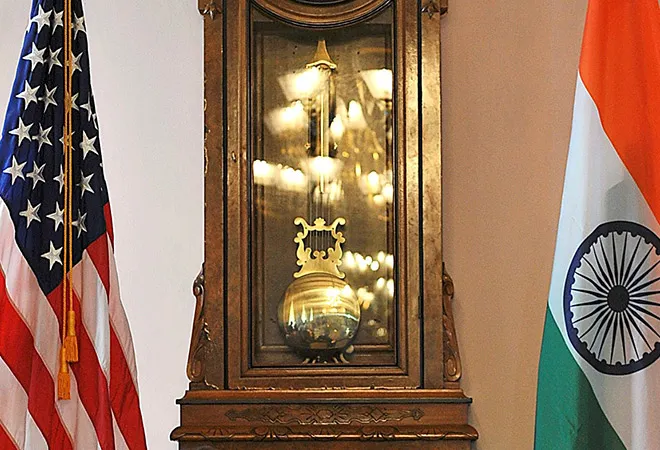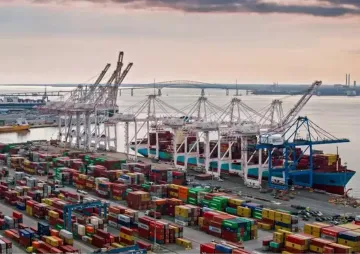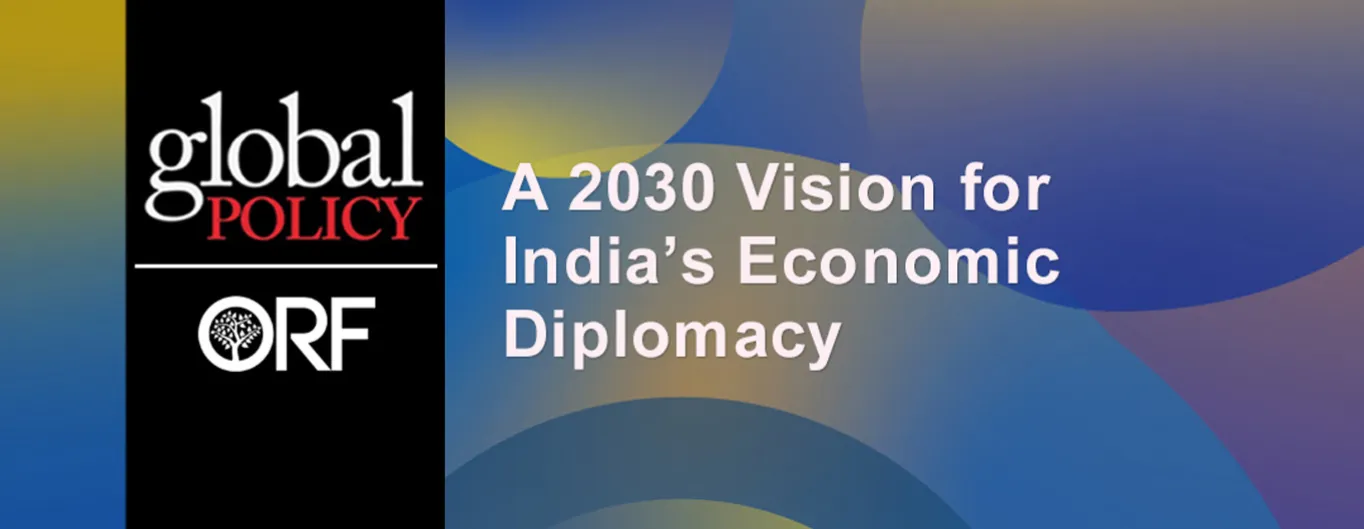
This article is part of the Global Policy-ORF publication — A 2030 Vision for India’s Economic Diplomacy.
The US is India’s most important economic partner today. In 2019-2020, it was India’s single largest trade partner, accounting for almost US$ 89 billion (11 percent of India’s total) in two-way goods trade<1>. It is the fifth-largest source of incoming foreign direct investment (FDI)<2>. However, these figures arguably understate the importance of the economic partnership. Services trade is a major component of bilateral commerce, accounting for over one-third of total trade (37 percent). Over 2,000 US companies currently have a presence in India, some — including such major corporations as GE, Cisco, Microsoft, and Amazon — being significant employers. In 2018-2019, over 200,000 Indian students studied in the US, a number that has reduced somewhat due to the COVID-19 pandemic. India provides a massive user base for US technology companies; it is already home to the largest number of Facebook users and other technology giants — many prevented from entering China’s market — see immense potential in India. About one in seven Silicon Valley startups were founded by Indians, with the impact of Indian-born entrepreneurs in the US felt equally in areas such as the biological sciences<3>. While India’s other economic relationships — with Europe, China, Japan, Southeast Asia, and the Gulf — are also intensifying, the US for now holds particular importance for India’s economic diplomacy.
But there are also areas where the US and India do not hold much value for each other — yet. Both are consumer-driven economies and net importers (they rank first and third, respectively, in terms of current account deficits). Regardless of the political party in power in both countries, ensuring employment for the middle class will be essential, making it difficult to offer concessions on trade or manufacturing. Barring select sectors, neither is a major exporting powerhouse of manufactured goods, along the lines of China, Germany, Japan or South Korea. In the US’s case, this is a consequence of its economic trajectory; in India’s case as a developing economy, it is often a product of insufficient competitiveness. Infrastructure is also not always a strong suit for the two countries, nor is government-backed institutional investment. At the same time, some areas that were previously underdeveloped have come online in recent years, such as energy and defence, two significant areas of trade and commercial cooperation that have emerged only relatively recently.
India’s development will require sourcing critical goods, investment and technologies; ensuring market access; absorbing best practices and knowledge; and leveraging international agreements for domestic competitiveness.
India’s economic engagement with the US over the next decade can be assessed along five dimensions — trade, migration, capital flows, technology, and standards and regulations. Trade is likely to remain a fraught subject but will depend in large part on the evolution of US manufacturing, India’s industrial development and the resolution of trade frictions. Migration will see bumps along the road but could quite conceivably result in a tightening of relations. Capital flows will depend in large part on the success of India’s post-COVID-19 economic recovery. Technology offers perhaps the greatest potential for accelerated economic links between the two countries, with wide-ranging effects on security, communications and the environment. Finally, standards and regulations may offer one of the more significant areas of India-US engagement, with global implications. As two large democratic economies, India and the US will have the potential (along with Europe and Japan) to shape global standards on sustainable development, international lending, telecommunications and banking systems, among a host of other areas. For India’s economic diplomacy over the next decade, these areas will be worth greater emphasis. India’s development will require sourcing critical goods, investment and technologies; ensuring market access; absorbing best practices and knowledge; and leveraging international agreements for domestic competitiveness.
Trade: Frictions amid flattening
Trade in goods is likely to remain a contested area, not just between India and the US, but globally. After the end of the Cold War, the world witnessed an enormous growth of cross-border trade, rising from 39 percent of global GDP to 61 percent in 2008. But following the global financial crisis, trade has plateaued, falling to 59 percent of global GDP by 2018. With the proverbial pie no longer growing, trade is increasingly viewed in zero sum terms. This also applies, if to a lesser degree, to services trade, as governments continue to prioritise employment growth in critical value-add sectors.
Ensuring jobs has become a concern for the leaderships of both countries amid fears of jobless and uneven growth, no matter the political party in power.
Trade is also extraordinarily politicised, for two reasons. One is sector-specific sensitivities. In both India and the US, narrow politically-mobilised constituencies can exert considerable influence over broader trade negotiations — including multilateral negotiations as at the World Trade Organisation — if they fear becoming disadvantaged. For example, in recent years, American medical device, pharmaceutical and dairy industries have lobbied the US government to take action against India for protecting its markets. Similarly, the retail and agricultural sectors in India have been resistant to trade liberalisation.
While sector-specific disputes have long been a feature of trade relations, an additional factor — especially after 2008 — has been concern over employment. In both the US and India, overall growth figures since the turn of the millennium have been encouraging (in fact, the US and India are the second and third largest contributors to global growth in that period). However, median incomes in the US have not grown significantly, while employment growth has not matched the demographic potential in India. Ensuring jobs has become a concern for the leaderships of both countries amid fears of jobless and uneven growth, no matter the political party in power. Making concessions on merchandise trade has consequently become more difficult.
In a post-pandemic world, goods trade and supply chains will be more closely associated with national security concerns and political trust.
Nonetheless, there have been opportunities for growth in bilateral relations. Prior to the COVID-19 pandemic, bilateral trade in goods and services had climbed from US$ 60 billion in 2009 to US$ 146 billion in 2019<4>. Indian purchases of energy (including liquefied natural gas), defence and commercial aviation had contributed further to US exports and narrowed the US deficit with India, which had been a point of focus for former US President Donald Trump. In a post-pandemic world, goods trade and supply chains will also be more closely associated with national security concerns and political trust. These factors do present some opportunities to bolster trade, including in key areas such as healthcare. Efforts at rerouting supply chains to ensure resilience offer additional opportunities. These may, in time, translate into select trade groupings and arrangements, even if recent efforts at multilateral trade negotiations involving both India (the Regional Comprehensive Economic Partnership) and the US (the Trans-Pacific Partnership) have been unsuccessful.
Overall, trade — particularly in merchandise — will remain a difficult prospect for India and the US. Sector-specific concerns and employment woes will continue to be factors, only partly offset by supply chain resilience initiatives. In the near-term, putting to rest niggling trade frictions, which defined both the Obama and Trump-era engagements with India, will be a priority. But a ‘phase one’ trade truce should be seen as only a first step towards setting the trade relationship on a more solid footing.
In the near-term, putting to rest niggling trade frictions, which defined both the Obama and Trump-era engagements with India, will be a priority.
Migration: The prospects for overhaul
The people-to-people links and the success of the Indian diaspora in the US have been heralded as among the major developments behind transforming the bilateral relationship. The Indian-American community is by many measures the wealthiest and best-educated ethnic group in the US. The people-to-people links, however, go beyond that. For India, it is manifested in the large number of students in the US (second after students from China), many of whom return to India. For its part, India has made it legally easier for people of Indian origin to live, work and invest in the country through the creation and expansion of the Overseas Citizen of India programme. This combination of factors has led to a large and growing number of business links between the two countries as well as research and entrepreneurial collaborations. The effects of these relationships are hard to quantify.
A combination of more restrictive immigration policies pursued by the Trump administration and the disruption caused by the pandemic have threatened the prospects of such mutually beneficial exchanges. Measures taken by the Trump administration affected several categories of migrants, three of which pertained to India. The first was student visas, as well as associated policies such as optional practical training. Proposals that students not be allowed to return to the US if they were engaging in remote learning from US universities (a situation brought about by the COVID-19 pandemic) were successfully challenged by universities, but threatened to deter future enrollment in US institutions. A second category was short-term skilled labour, often through the H-1B visa programme. Oversubscribed by Indian nationals, the H-1B visa has become controversial, with many US officials believing that it no longer serves its original purpose and is often exploited by employers. Finally, the process of achieving permanent residency (“green cards”) through employment had been restricted by quotas, something a Biden administration has committed to overturning.
If a political deadlock is broken, it is possible that the US might move to a points-based system, akin to countries like Australia.
There is a widespread belief among leaders on both the political right and left in the US that the current immigration regime is untenable. But more ambitious immigration reform has been resisted by certain constituencies, including the Congressional Hiic Caucus. Asian-Americans — of whom Indian-Americans are the third-largest group, after Chinese-Americans and Filipino-Americans — have been the major beneficiaries of changes to US immigration policy since the early 1990s. They have since become the fastest-growing immigrant group in the country. Hiic Americans, however, remain the largest group of first-generation migrants and are concerned that further wholescale changes to US immigration will come to their disadvantage.
If a political deadlock is broken, it is possible that the US might move to a points-based system, akin to countries like Australia. Such an immigration regime would conceivably prioritise individuals who are younger, highly educated, English-speaking, and have degrees in science, technology, engineering or mathematics. Should they be instituted, such criteria would considerably benefit Indian-Americans, resulting in greater Indian migration to the US. But such a comprehensive breakthrough — resulting in a replacement of the H-1B programme — is by no means a foregone conclusion.
The challenge will be how best to harness the diaspora and educational exchanges to accelerate the two countries' economic well-being.
Overall, the prospects for continued growth in people-to-people contacts between the two countries appear positive. The challenge will be how best to harness the diaspora and educational exchanges to accelerate the two countries' economic well-being. The challenges will include, but not be restricted to, India’s engagement with second- and third-generation Indian-Americans, the recognition and utilisation of US degrees in India, expanding access to quality US education for Indians (including possibly by encouraging the establishment of campuses in India), and incentivising research collaborations between individuals and institutions in both countries. Some of the benefits will accrue naturally, but policy interventions can help accelerate and thicken links, to the economic benefit of both countries.
Capital: Following the money
Over the past two decades, capital flows between India and the US have undoubtedly increased, as the overall economic relationship has grown. However, as with other elements of economic ties, it is arguably still underdeveloped. Much of the focus, given the more competitive context surrounding trade and jobs, has been around FDI. In 2019, the stock of US FDI in India stood at US$ 45.9 billion. By comparison, US FDI in some large Asian economies is significantly higher — US$ 162 billion in Australia, US$ 126 billion in Japan and US$ 16 billion in mainland China<5>. Meanwhile, Indian FDI in the US is US$ 5 billion, also suggesting considerable room for growth. As with many countries, ensuring regulatory and legal clarity through an instrument such as a bilateral investment treaty would encourage investors in both countries to work with the other. FDI is not the only form of capital flows between the two countries. Indirect or portfolio investment is significant, and there is considerable potential for expanding secondary markets in India. The further development of Mumbai as a financial hub is important.
The further development of Mumbai as a financial hub is important.
Other forms of capital flows have decreased in relevance over time, including government-backed lending. US development assistance to India, for example, was over US$ 200 million per year two decades ago but has fallen to less than half that amount (US$ 97 million in 2019), in part a consequence of India’s development. By contrast, remittance flows from the US to India have grown steadily. In 2017, US$ 11.7 billion was remitted from the US, making it the second-largest source of the US$ 69 billion in remittances to India that year<6>. Whether that figure continues to grow or plateaus will largely depend on US immigration policy over the next decade.
Ultimately, the future of capital flows from the US to India (and vice-versa) will depend significantly on commercial diplomacy — government engagement with the private sectors. For the Indian government, it will require convincing investors about the benefits of committing to its country. While India has benefited in sectors where market access to China is limited, such as e-commerce and retail, a surge across the board has not yet occurred. Like diaspora diplomacy, commercial diplomacy has been something that the Indian government has learned over the past quarter-century. But now with some track record, it will necessitate working more seamlessly with entities in India to facilitate foreign investment (such as the Department for Promotion of Industry and Internal Trade or state governments).
Like diaspora diplomacy, commercial diplomacy has been something that the Indian government has learned over the past quarter-century.
Technology: From frustration to promise
Leveraging diplomatic relations to seek access to advanced technology has been a challenge for India almost since independence. The initial emphasis was on strategic technologies — defence, nuclear energy and space — but a combination of India’s non-alignment, US export controls and questions of cost prevented a fruitful partnership from emerging in many of these areas. On the other hand, India was perhaps the single biggest beneficiary of US agricultural technology in the 1960s, resulting in the Green Revolution. The introduction of new strains of grain, facilitated by the US government and affiliated entities, resulted in bumper crop yields and India becoming no longer reliant on food aid. In a very different way, technology was a prime catalyst for the India-US economic relationship taking off in the 1990s. In this case, it was demand for skilled labour in the US that led to the Indian information technology boom, something the Indian economy still benefits from.
Since India’s 1998 nuclear tests, when severe sanctions were imposed on India by the US government, successful diplomatic efforts were made to free India from technology denials. This was initially under the Next Steps in Strategic Partnership umbrella, but accelerated with the passage of the civilian nuclear agreement between 2005 and 2008<7>. This paved the way for India to be made a major defence partner under the Obama administration and be categorised in one of the highest categories by the Department of Commerce under the Strategic Trade Authorisation initiative, essentially minimising licensing requirements for export certain sensitive technologies<8>.
Questions of costs, public procurement and non-competitive academic environments (among other factors) prevent India from taking full advantage of technological opportunities presently on offer.
While Indian diplomatic efforts have been successful over 20 years in lowering (and in some fields, eliminating) barriers to technology, the challenge has moved into other domains. One is offering incentives for the transfer and absorption of technology from the US private sector. This requires Indian entities (whether government or private players) to pay high costs or offer secondary benefits for cutting-edge technology. Additionally, it requires India to have the means — whether through private research and development or universities — to absorb that technology. Questions of costs, public procurement and non-competitive academic environments (among other factors) prevent India from taking full advantage of technological opportunities presently on offer. Government-led efforts to improve educational links will be necessary.
Another line of effort will relate to technology policy and standards. In an era of greater competition, particularly with China, ensuring common technological security and compatibility standards will be necessary. This will extend to several areas, possibly most immediately on data security, 5G telecommunications, and artificial intelligence. India-US efforts at cooperating in these areas, which may take the form of multilateral initiatives such as the D-10 or Global Partnership on Artificial Intelligence, will be a certain feature of bilateral diplomatic ties in the years ahead.
In an era of greater competition, particularly with China, ensuring common technological security and compatibility standards will be necessary.
Standards and regulations
Finally, beyond seeking market access, critical materials (for instance, energy), knowledge, investment and technology, India will have to engage the US in setting standards, norms and regulations. This is an opportunity to deepen or facilitate cooperation in certain areas of economic or commercial cooperation. For example, aligning export controls ensures that India can receive access to critical technology. Additionally, such a process can make India more competitive at home, as a catalyst for reform.
In many cases, this will take the form of issue-specific multilateral negotiations. Climate change offers one example of recent consensus building, and the Paris Climate Treaty now functions as a benchmark for international cooperation. Newer initiatives related to climate and sustainability, such as the International Solar Alliance and Coalition for Disaster Resilient Infrastructure, represent Indian attempts at setting norms and standards on related issues. Similar opportunities are discernible in other areas. Trade and investment could well end up being either more problematic or bilateral, but public health, education and technology will all assume greater urgency in a post-COVID-19 environment. Other norms will take center stage in response to attempts by certain rising powers, most notably China, to set them unilaterally. A critical example relates to the Belt and Road Initiative, which India challenged in 2017 on normative grounds. Subsequent efforts by both India and the US to offer and enforce alternative norms for infrastructure lending — based on financial sustainability, transparency, environmental standards, national sovereignty and local demand — have been developed in parallel, although discussions have taken place on US-led proposals such as the Blue Dot Network. Nonetheless, there are a host of similar issues that will require better coordination in a post-pandemic world, as the international order grows accustomed to new power realities.
Trade and investment could well end up being either more problematic or bilateral, but public health, education and technology will all assume greater urgency in a post-COVID-19 environment.
Conclusion
The opportunities and challenges for Indian economic diplomacy in its efforts at engaging the US over the next decade are immense. The US holds enormous importance for India’s future economic trajectory, not necessarily as the dominant actor in every facet of international economic exchange, but in its totality. But it is logical to assess what India hopes to derive from that relationship. In an ideal world, India seeks market access, the import of critical raw and intermediate materials, capital (whether in the form of investment, remittances, loans or grants), broader and deeper people-to-people exchanges, the transfer of technology and know-how, and cooperation in setting global norms and standards. Many of the steps deterring or complicating these objectives are domestic in nature, often a product of vested interests or insufficient capacity in India. At the same time, other barriers that had previously been imposed by one government or the other (such as India’s license-permit-quota regime or US export controls) are less relevant today.
The agenda over the next decade will therefore include, but not be limited, to the following possibilities:
• A “phase one” trade agreement between India and the US — or more accurately a “trade truce” — that reaches basic agreement on several outstanding points of bilateral trade friction.
• Discussions towards a higher quality trade arrangement, which may take the form of a bilateral or multilateral preferential trade agreement. At its most ambitious, such an arrangement might resemble a modified Trans-Pacific Partnership, although in a form that is more politically palatable to both countries.
• A bilateral investment treaty that clarifies questions surrounding regulatory unpredictability, particularly in India.
• A more robust Indian commercial diplomatic presence in the US that is coordinated with line ministries and state governments to facilitate large-scale investment.
• An education dialogue, with the objectives of facilitating the establishment of US higher education campuses in India, enhancing research and development collaboration, and recognising degrees conferred by educational institutions in the two countries.
• Multilateral discussions on setting or strengthening global norms on such issues as climate change and sustainability, emerging technology standards (such as data, artificial intelligence, 5G and automation), lending and international finance, and export controls.
Endnotes
<1> Department of Commerce, “Export Import Data Bank,” Ministry of Commerce and Industry, Government of India, 2020.
<2> Department for Promotion of Industry and Internal Trade, “FDI Statistics,” Ministry of Commerce and Industry, Government of India, 2020.
<3> Neesha Bapat, “How Indians Defied Gravity and Achieved Success in Silicon Valley,” Forbes, 15 October 2012.
<4> Office of the U.S. Trade Representative, “India,” Executive Office of the President, 2019.
<5> Office of the U.S. Trade Representative, Executive Office of the President, 2019.
<6> “Remittance Flows Worldwide in 2017,” Pew Research Center, 3 April 2019.
<7> U.S. Department of State, United States - India Joint Statement on Next Steps in Strategic Partnership, U.S. Department of State, 17 September 2004.
<8> “India Third Asian Nation to Get STA-1 Status from U.S.,” The Hindu, 4 August 2018.
The views expressed above belong to the author(s). ORF research and analyses now available on Telegram! Click here to access our curated content — blogs, longforms and interviews.




 PREV
PREV


